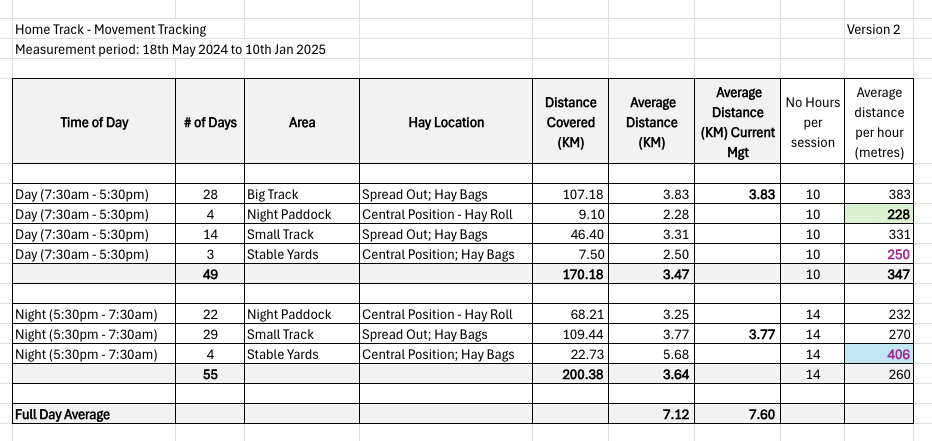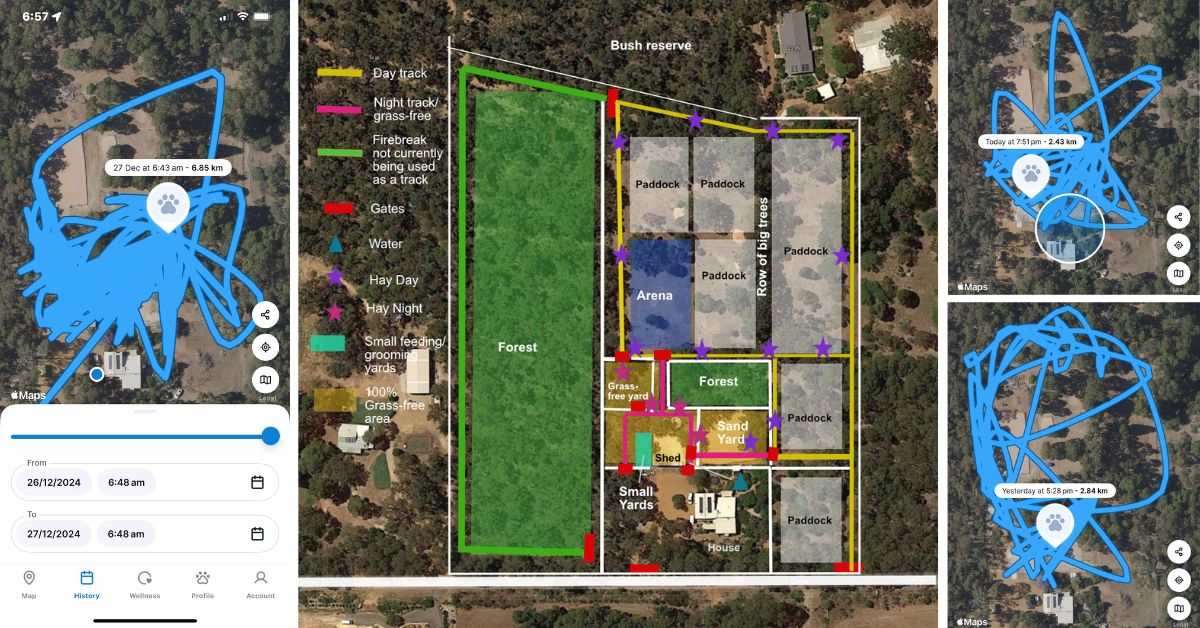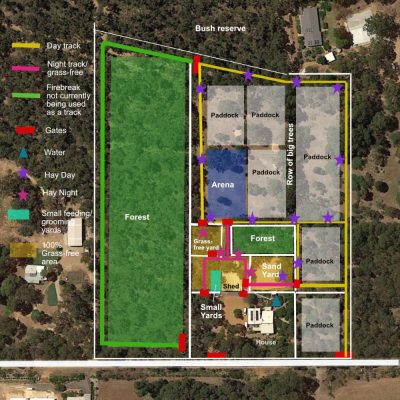What started me thinking about tracks
Our property is in the Perth Hills, Western Australia on land that is mostly protected forest, or bush as it’s called here, and paddock areas that are reclaimed bush, or were so when we bought the property 8 years ago.
The property has no established seeded pasture, very poor soil and a lot of rock. The paddock grass that’s here now, is mostly ryegrass from the ryegrass hay that’s been fed over the years. Grass is abundant in winter and spring, and dies out in summer and autumn leaving dry ground, or bare ground if horses are grazing or walking on it.
In WA, because of our location, climate and soils, we have a limited choice when it comes to hay for horses – traditionally oaten, and more recently, meadow hay which is mostly ryegrass. Our meadow hay is harvested to achieve the lowest sugar hay possible, around the 10% ESC mark, despite the ryegrass not being a low-sugar plant.
In 2021, my 15 year old 16hh Clydesdale X Warmblood mare Daisy was diagnosed with Cushings after a laminitis episode triggered by grass. She was one of two horses on the property at the time, the other was a 19 year old 13hh Quarter Horse Riding Pony X gelding in good health, except for a susceptibity to ulcers because of his anxious disposition. Daisy’s diagnosis started me on the journey of creating a track, as a way to keep her off the grass, while keeping her moving.
Creating a track from scratch takes time and money, and when you’re putting fence posts into rocky ground, it takes quite a lot of both. We created a track for the horses to use during the day, but we still had to keep them in a small paddock at night with very little grass. We thought we were managing the situation well until the winter of 2023, when without warning, Daisy had another laminitis episode that she didn’t recover from.
Don’t misunderstand this brief mention of her loss as an indication of how much I cared about the event. I bought Daisy on the day she was born, and spared no effort or expense with her care. I think I cried every day of the three months of her care and for many months after that, but this article isn’t about that, so I’ll leave it there.
What made me decide to undertake this project
In Feb 2024 another red mare, a 9 year old 15hh Clayton Station Waler mare called Melody came to the property, with no history of metabolic issues. In consultation with her highly experienced owner, we started off by keeping both horses on the big track during the day, with low-sugar hay bags spread out, and in the night paddock on a low-sugar hay roll.
There are a few reasons we have never kept horses on the big track 24/7. The old boundary fencing consisted of 3 strands of metal wire, and we used to get lots of neighbourhood dogs and foxes wandering through the property. The track is on a slope with lots of trees, sharp corners and absolutely no ambient light. There are only two horses on it, and once one moves away, if the other panics, it could end in disaster.
Considering the new horse and the pony that was already here, had no history of metabolic issues, and because I was still questioning my own judgement since I’d lost Daisy, I started questioning whether a full grass-free track setup was really the right thing to do or whether I should just move the horses between paddocks as everyone else seemed to do.
In the absence of data to make a decision, I decided to start measuring the distances they covered in a paddock and track environment, to establish the facts so that I can could make an informed decision for myself. I also knew that I had a natural experiment coming up, as I had to keep the horses in their night paddock on a hay roll, day and night for 4 days as we were having the old boundary fencing replaced.
More natural experiments than I’d planned
In June 2024 with no warning, Melody had a laminitis episode and was diagnosed with EMS.
To begin with, I was devastated. But after a few days of tears and feeling sorry for myself, I realised that if I was set up now to manage anything, it was this, because with a few more changes, we could easily create the grass-free track that was in my original plan for Daisy’s management, that would make it possible to keep Melody healthy in the long term.
We started off by moving both horses into the small grass-free stable yards intended for short stays (farrier, feeding) while Melody began her recovery. I decided to keep measuring the distances the pony was travelling, as we transitioned both horses out of the stable yards and into progressively larger areas.
The pony has always disliked being confined to small areas for any length of time, but there was no other option, as Melody was the priority at this point. We got started straight away, adding a few bits of fencing around the shed to create a grass free track that incorporated a 20m x 20m soft sand yard, an 18m x 13 cracker dust yard and 80m of surfaced ferrecrete/gravel track. Within a week, we were able to start letting him out of his stable yard for short periods of time, while still being within view of Melody.
Once Melody was comfortable enough, we were able to let her out into selected areas of the small track during the day. Later on, we could keep her on the new small track 24/7, with just an hour in the stables morning and night for meals. Once the big track was grass free at the start of summer, the horses went out there from 7:30am until 5:30pm each day and then onto the small track all night.
We added a small amount of ambient lighting to the small track, to make it safe to use at night.
Property Layout
This is an approximate layout of the nearly 9 acre property, of which a big chunk is virgin forest/bush.
Monitoring Summary
This is a summary of the information gathered from the Tractive device which was attached to the pony’s halter during the 8 month experiment. The full results of the experiment are available by clicking on the button below. Because the day session went for 10 hours and the night session went for 14, I averaged the full day/night results by dividing the total distance travelled, by the number of hours to arrive at an average distance per hour figure.

EDIT 19/1/25: I noticed that one of the Night/Stable Yards entries for 10/7/24 had been put in the Day section. This version of the summary removes it from the Day average and adds it into the Night average.
Full Monitoring Results
EDIT (added 13/1/25): The results of the experiment were collated as follows. I created a Microsoft Form to collect the data. Every day, I would query the Tracker app with the date/time range for each day/ night, which shows up as the Google Maps screen with the blue scrawly lines on it that you can see in the header image of this article. I would add that information, plus additional management information to the Microsoft Form, which stores each entry in a Microsoft Excel spreadsheet. At the end of the experiment, I formatted the entries by sorting them into time of day and area. This made it possible to calculate averages and other information.
Definitions
- Tracker: Tractive Tracker
- Halter: Le Mieux breakaway halter
- Test subject: 13hh now 23 y/o Qtr Horse/ Australian Riding Pony gelding in good health
- Same horse, different environments
- Day: 7:30am to 5:30pm
- Night: 5:30pm to 7:30am
- Stable Yard: 6m x 4m (ourdoors) + 3m x 3m stable (indoors)
- Night Paddock: 30m x 40m rectangle, part bare earth, part unimproved grass
- Small Track (grass-free): 130m – 2 surfaced areas (20m x 27m and 18m x 13m) connected by 80m of surfaced gravel track.
- Big Track: 725m of unsurfaced dirt tracks, between 3 and 9m wide
Observations
- The big track is 725m metres long and the small track is 130m metres long.
- The average distance covered on the big track during the day was 383 metres per hour, compared to 331 metres per hour on the small track during the day.
- Movement was lower when hay was in an unlimited supply (hay roll) and in a central position, compared with when it was in hay nets, spaced apart.
- Movement in a particular area was highest when the horses first starting using it. Movement decreased, the longer they were in it.
- When the horses were in the small track 24/7, they covered less ground on average during the night (270 metres per hour) compared with during the day (331).
- The area/time of day with the highest average rate of movement per hour, was the stable yards at night, because the pony disliked being there.
- The area with the lowest average rate of movement per hour, was the night paddock, with the horses on a central hay roll. They were most comfortable in this area, and the hay was in a central spot so they didn’t have to move far to get it.
- The distance travelled in the night paddock when hay was placed in the four furthest corners, was roughly equivalent to the distance travelled on the track, on a day of high movement (was only able to test this twice before horses could no longer be in this area).
- The top 5 lowest distances travelled per session were in the stable yards during the day and the night paddock with a central hay roll in it.
- The top 5 highest distances travelled per session were in the stable yards at night and the big track during the day.
- The lowest recorded distance in a session was 1.4km in the stable yards during a day.
- The highest recorded distance in a session was 6.48km in the stable yards during a night.
- In a track setting, the horses would go to the same areas, at roughly the same times each day, based on the features of that area.
- In a track setting or where hay is offered in hay bags that are spaced apart, far less hay is eaten (this is an entire subject on its own for another time).
Projections
Because I’m a nerd who likes seeing the big picture effects of small changes, these are just for fun.
- 383 metres per hour on the big track (725m), 24 hours a day for 365 days, equals 3,350,080 metres or 3,350 kilometres travelled in a year.
- 331 metres per hour on small track (130m), 24 hours a day for 365 days, equals 2,899,560 metres or 2,900 kilometres travelled in a year.
- If my maths is correct, that’s means a 458% increase in distance, only offers a 16% increase in distance travelled.
And when considering possible projections for different styles of management, bearing in mind that the same rates wouldn’t apply to every horse/setup:
- A horse kept in our current setup is likely to travel around 2,774 km per year – 7.6km per day x 365 days per year.
- The most pessimistic view for a horse kept in our stable yard at night, and in our (night) paddock on a hay roll during the day, is likely to be 1,059 km per year based on the lowest value for stable yard at night and lowest value for night paddock/hay roll during the day = 61.82% less.
- The average outcome for a horse kept night and day in our small paddock on a hayroll, is likely to be 1,960 km per year based on night paddock averages day and night (adjusted for the 2 nights with spread out hay) = 41.53% less.
Conclusions
- Tracks, particularly surfaced ones, are useful for the management of horses who can’t tolerate the grass that is available to them.
- The highest rate of movement, isn’t necessarily the best outcome.
- The size of the available area isn’t necessarily correlated with the distance a horse will travel.
- Horses are more active when they have a reason to move, for example through the placement of incentives like hay, water and particular areas they like to spend time in.
- Horses are more active when there is change or new areas to explore in their environment.
- Provided horses can tolerate the grass/plant material available to them in paddock areas, you can achieve similar goals in a paddock setting as you can in a track setting, through the placement of incentives.
Thank you
The thing about data and statistics, is that you can use the same results to prove or disprove just about anything, provided it sounds convincing enough.
I’ve done my best to be impartial and rational in the design of this experiment and the interpretation of the results.
If you have different views or see the results in a different light, I’d love to hear your thoughts. The easiest place to do that, is on the Home Track Facebook page post, where this article will be posted and linked from.
Not sure what a track is? Start with Jaime Jackson’s excellent book Paddock Paradise: A guide to natural horse boarding.


